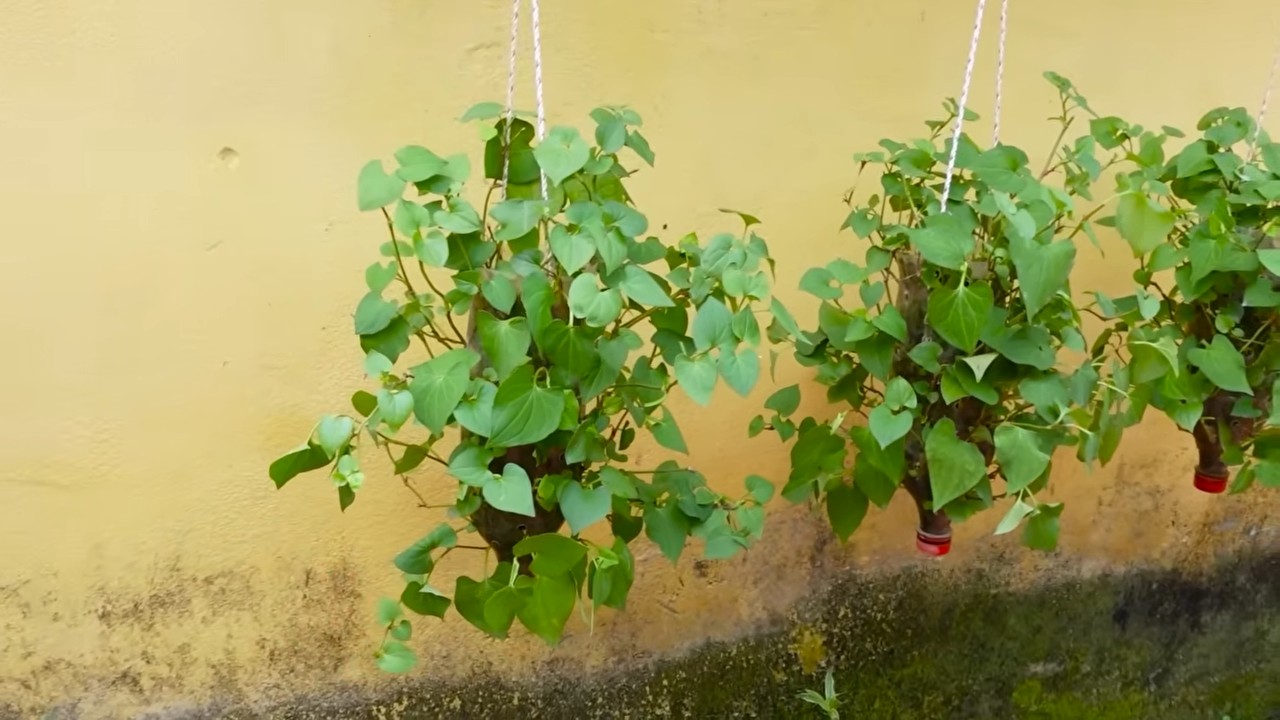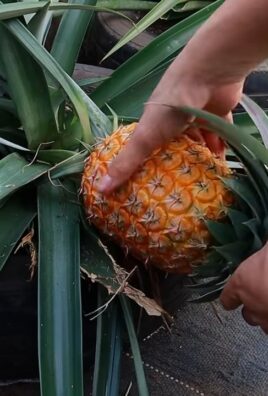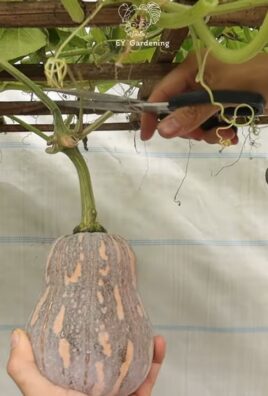Harvesting Fresh Fish Mint from your own garden is easier than you might think, and I’m here to show you how! Have you ever been captivated by the unique, almost citrusy aroma of Southeast Asian cuisine? Chances are, you’ve encountered Fish Mint, also known as Houttuynia cordata. This vibrant herb, deeply rooted in Asian culinary traditions, has been used for centuries not only for its distinctive flavor but also for its purported medicinal properties.
But what if I told you that you could bring this exotic flavor right to your doorstep? Forget expensive grocery store trips and wilted herbs. Imagine stepping into your backyard and harvesting fresh Fish Mint whenever you need it. This DIY guide will equip you with the knowledge and simple techniques to cultivate and harvest this amazing herb successfully, even if you don’t have a green thumb.
Many people struggle with keeping herbs alive, let alone knowing when and how to harvest them properly. This often leads to wasted effort and disappointing results. But with a few simple tricks and a little bit of know-how, you can enjoy a continuous supply of fresh, flavorful Fish Mint, ready to elevate your culinary creations and impress your friends and family. Let’s dive in and unlock the secrets to a bountiful Fish Mint harvest!

Fischminze ernten und verwenden: Dein DIY-Leitfaden für frische Aromen
Hey du! Bist du bereit, deine Küche mit dem einzigartigen Geschmack von frischer Fischminze zu bereichern? Fischminze, auch bekannt als *Houttuynia cordata*, ist eine faszinierende Pflanze mit einem erfrischenden, leicht fischartigen Aroma, das asiatischen Gerichten eine besondere Note verleiht. In diesem Artikel zeige ich dir, wie du Fischminze richtig erntest und vielseitig in deiner Küche einsetzen kannst. Lass uns loslegen!
Die richtige Erntezeit und -technik
Der Schlüssel zu aromatischen Fischminze-Blättern liegt in der richtigen Ernte. Hier sind ein paar Tipps, die du beachten solltest:
* Wähle den richtigen Zeitpunkt: Am besten erntest du Fischminze am Morgen, nachdem der Tau verdunstet ist. Dann sind die ätherischen Öle am konzentriertesten und die Blätter haben das intensivste Aroma.
* Schneide richtig: Verwende eine saubere Schere oder ein scharfes Messer, um die Stängel knapp über einem Blattknoten abzuschneiden. So förderst du das Wachstum neuer Triebe.
* Ernte regelmäßig: Je öfter du erntest, desto buschiger wird deine Pflanze. Scheue dich also nicht, regelmäßig Blätter zu pflücken.
* Vermeide die Blütezeit: Während der Blütezeit kann das Aroma der Blätter etwas bitter werden. Wenn deine Fischminze blüht, entferne die Blüten, um die Blattproduktion anzuregen.
Schritt-für-Schritt-Anleitung zur Ernte von Fischminze
1. Vorbereitung: Stelle sicher, dass du eine saubere Schere oder ein scharfes Messer zur Hand hast. Eine Schüssel oder ein Korb zum Sammeln der geernteten Blätter ist ebenfalls hilfreich.
2. Inspektion der Pflanze: Untersuche deine Fischminze-Pflanze sorgfältig. Achte auf gesunde, grüne Blätter ohne Anzeichen von Schädlingen oder Krankheiten.
3. Auswahl der Stängel: Wähle die Stängel aus, die du ernten möchtest. Achte darauf, dass sie ausreichend Blätter haben und nicht zu dünn sind.
4. Schneiden der Stängel: Schneide die Stängel mit der Schere oder dem Messer knapp über einem Blattknoten ab. Ein Blattknoten ist die Stelle, an der ein Blatt aus dem Stängel wächst.
5. Sammeln der Blätter: Lege die geernteten Stängel in deine Schüssel oder deinen Korb.
6. Wiederholung: Wiederhole die Schritte 3 bis 5, bis du die gewünschte Menge an Fischminze geerntet hast.
7. Nach der Ernte: Gieße deine Fischminze-Pflanze nach der Ernte, um ihr zu helfen, sich zu erholen.
Fischminze richtig waschen und lagern
Nach der Ernte ist es wichtig, die Fischminze richtig zu waschen und zu lagern, um ihre Frische und ihren Geschmack zu bewahren.
1. Waschen: Fülle eine Schüssel mit kaltem Wasser und gib die geernteten Fischminze-Blätter hinein. Bewege die Blätter vorsichtig im Wasser, um Schmutz und Ablagerungen zu entfernen.
2. Trocknen: Lege die gewaschenen Blätter auf ein sauberes Küchentuch oder eine Salatschleuder und lasse sie trocknen. Du kannst sie auch vorsichtig mit einem Küchentuch abtupfen.
3. Lagern: Es gibt verschiedene Möglichkeiten, Fischminze zu lagern:
* Im Kühlschrank: Wickle die trockenen Blätter in ein feuchtes Papiertuch und lege sie in einen Plastikbeutel oder eine luftdichte Dose. So bleiben sie bis zu einer Woche frisch.
* Einfrieren: Hacke die Blätter fein und friere sie in Eiswürfelbehältern mit Wasser oder Öl ein. So hast du immer frische Fischminze zur Hand.
* Trocknen: Binde die Stängel zu kleinen Bündeln zusammen und hänge sie an einem kühlen, trockenen und dunklen Ort auf. Sobald die Blätter trocken sind, kannst du sie in einem luftdichten Behälter aufbewahren.
Verwendung von Fischminze in der Küche
Fischminze ist ein unglaublich vielseitiges Kraut, das in vielen verschiedenen Gerichten verwendet werden kann. Hier sind ein paar Ideen, wie du sie in deiner Küche einsetzen kannst:
* Frische Salate: Füge gehackte Fischminze zu deinen Salaten hinzu, um ihnen einen frischen, aromatischen Kick zu verleihen. Sie passt besonders gut zu asiatischen Salaten mit Gurken, Karotten und Reisnudeln.
* Sommerrollen: Fischminze ist ein Muss in vietnamesischen Sommerrollen. Sie verleiht den Rollen einen erfrischenden Geschmack und eine angenehme Textur.
* Suppen und Eintöpfe: Gib gehackte Fischminze kurz vor dem Servieren zu deinen Suppen und Eintöpfen hinzu. Sie passt besonders gut zu klaren Brühen und asiatischen Nudelsuppen.
* Fleisch- und Fischgerichte: Verwende Fischminze als Marinade oder Gewürz für Fleisch- und Fischgerichte. Sie harmoniert gut mit Geflügel, Schweinefleisch und Meeresfrüchten.
* Getränke: Füge Fischminze zu deinen Cocktails, Limonaden oder Tees hinzu. Sie verleiht den Getränken einen erfrischenden und exotischen Geschmack.
Rezept-Inspiration: Vietnamesischer Fischminze-Salat (Gỏi Cá Diêu Hồng)
Hier ist ein einfaches Rezept für einen köstlichen vietnamesischen Fischminze-Salat, den du mit deiner frisch geernteten Fischminze zubereiten kannst:
Zutaten:
* 200g Fischfilet (z.B. Tilapia oder Rotbarsch)
* 1 Karotte, julienne geschnitten
* 1 Gurke, julienne geschnitten
* 1 rote Zwiebel, in dünne Scheiben geschnitten
* 1 Handvoll Erdnüsse, geröstet und gehackt
* 1 Bund Fischminze, gehackt
* 1 Bund Koriander, gehackt
* 1 rote Chili, fein gehackt (optional)
* Fischsoße-Dressing (siehe unten)
Fischsoße-Dressing:
* 3 EL Fischsoße
* 2 EL Limettensaft
* 1 EL Zucker
* 1 Knoblauchzehe, fein gehackt
* 1 rote Chili, fein gehackt (optional)
Zubereitung:
1. Fisch zubereiten: Dämpfe, brate oder grille das Fischfilet, bis es gar ist. Lasse es abkühlen und zerpflücke es dann in kleine Stücke.
2. Gemüse vorbereiten: Schneide die Karotte, Gurke und rote Zwiebel in feine Streifen oder Scheiben.
3. Dressing zubereiten: Vermische alle Zutaten für das Fischsoße-Dressing in einer kleinen Schüssel, bis sich der Zucker aufgelöst hat.
4. Salat zusammenstellen: Gib das Gemüse, den Fisch, die Kräuter und die Erdnüsse in eine große Schüssel. Gieße das Dressing darüber und vermische alles gut.
5. Servieren: Serviere den Salat sofort oder stelle ihn für eine Weile in den Kühlschrank, damit die Aromen sich entfalten können.
Tipps und Tricks für den Anbau von Fischminze
Wenn du noch keine Fischminze in deinem Garten hast, solltest du unbedingt darüber nachdenken, sie anzupflanzen. Hier sind ein paar Tipps, die dir dabei helfen:
* Standort: Fischminze bevorzugt einen halbschattigen Standort mit feuchtem, gut durchlässigem Boden.
* Aussaat: Du kannst Fischminze aus Samen ziehen oder Stecklinge von einer bestehenden Pflanze nehmen.
* Bewässerung: Achte darauf, dass der Boden immer feucht ist, aber nicht durchnässt.
* Düngung: Dünge deine Fischminze-Pflanze regelmäßig mit einem organischen Dünger.
* Vermehrung: Fischminze kann sich schnell ausbreiten. Wenn du das verhindern möchtest, pflanze sie in einen Topf oder einen abgegrenzten Bereich.

Conclusion
So, you’ve learned the secrets to harvesting fresh fish mint, and now it’s time to put that knowledge into action! This isn’t just about adding another herb to your garden; it’s about unlocking a world of culinary possibilities and experiencing the unique, vibrant flavor that only freshly harvested fish mint can provide.
Why is this DIY trick a must-try? Because store-bought fish mint, if you can even find it, simply doesn’t compare to the intensity and freshness of homegrown. The delicate leaves bruise easily, and the volatile oils that give fish mint its distinctive taste dissipate quickly after harvesting. By growing and harvesting your own, you’re guaranteeing the most potent and flavorful experience possible. You’re also gaining control over the quality of your ingredients, ensuring that your fish mint is free from pesticides and other harmful chemicals.
Beyond the superior flavor, harvesting your own fish mint is incredibly rewarding. It connects you to the natural world, allowing you to appreciate the process of growing your own food. It’s also a sustainable practice, reducing your reliance on commercially grown herbs and minimizing your environmental impact.
But the benefits don’t stop there. This DIY trick is also incredibly versatile. Once you’ve mastered the art of harvesting, you can experiment with different ways to use your fresh fish mint.
Here are a few suggestions and variations to get you started:
* **Infused Oils:** Steep freshly harvested fish mint leaves in olive oil or sesame oil to create a flavorful infusion for drizzling over salads, noodles, or grilled meats.
* **Fish Mint Tea:** Brew a refreshing and aromatic tea by steeping fresh or dried fish mint leaves in hot water. Add a squeeze of lemon or a touch of honey for extra flavor.
* **Vietnamese Spring Rolls (Gỏi cuốn):** Fish mint is a staple ingredient in Vietnamese spring rolls, adding a refreshing and herbaceous note to the dish.
* **Salads:** Chop fresh fish mint leaves and add them to salads for a unique and flavorful twist. It pairs particularly well with Asian-inspired salads.
* **Soups and Stews:** Add fish mint to soups and stews during the last few minutes of cooking to infuse them with its distinctive flavor.
* **Fish Mint Pesto:** Blend fresh fish mint leaves with garlic, nuts, Parmesan cheese, and olive oil to create a unique and flavorful pesto.
Don’t be afraid to experiment and find your own favorite ways to use this versatile herb. The possibilities are endless!
We strongly encourage you to try this DIY trick and experience the joy of harvesting your own fresh fish mint. It’s a simple, rewarding, and delicious way to elevate your cooking and connect with nature.
Once you’ve tried it, we’d love to hear about your experience! Share your tips, tricks, and favorite recipes in the comments below. Let’s build a community of fish mint enthusiasts and inspire others to discover the magic of homegrown herbs. Happy harvesting!
FAQ
What is the best time of day to harvest fish mint?
The best time to harvest fish mint is in the morning, after the dew has dried but before the sun gets too hot. This is when the leaves are at their most hydrated and flavorful. Harvesting in the heat of the day can cause the leaves to wilt and lose some of their essential oils. Aim for a cool, dry morning for optimal results.
How often can I harvest fish mint?
You can harvest fish mint regularly throughout the growing season, as long as you don’t take more than one-third of the plant at a time. This will allow the plant to continue to grow and produce new leaves. Regular harvesting also encourages bushier growth, resulting in a more abundant supply of fish mint. Avoid harvesting late in the season, as this can weaken the plant before winter.
How do I store harvested fish mint?
Freshly harvested fish mint is best used immediately for the most intense flavor. However, if you need to store it, there are several options:
* **Refrigeration:** Wrap the leaves in a damp paper towel and store them in a plastic bag in the refrigerator. This will keep them fresh for a few days.
* **Freezing:** Freeze the leaves in ice cube trays filled with water or oil. This is a great way to preserve the flavor for longer periods.
* **Drying:** Dry the leaves by hanging them upside down in a cool, dark, and well-ventilated place. Once dried, store them in an airtight container. Dried fish mint has a less intense flavor than fresh, but it can still be used in teas and soups.
My fish mint plant is spreading aggressively. How can I control it?
Fish mint is known for its aggressive growth habit, so it’s important to take steps to control its spread. The best way to do this is to grow it in a container or raised bed. This will prevent the roots from spreading into the surrounding soil. You can also use root barriers to contain the plant. Regularly prune the plant to keep it from getting too large. If you notice any runners spreading beyond the desired area, remove them immediately.
What are some common pests and diseases that affect fish mint?
Fish mint is generally a hardy plant, but it can be susceptible to certain pests and diseases. Common pests include aphids, spider mites, and slugs. These can be controlled with insecticidal soap or neem oil. Diseases such as powdery mildew and root rot can also affect fish mint. To prevent these diseases, ensure good air circulation around the plant and avoid overwatering.
Can I grow fish mint indoors?
Yes, you can grow fish mint indoors, but it requires bright light and well-drained soil. Place the plant near a sunny window or under grow lights. Water regularly, but avoid overwatering. Make sure the pot has drainage holes to prevent root rot. Indoor-grown fish mint may not be as vigorous as outdoor-grown plants, but it can still provide a steady supply of fresh leaves.
What does fish mint taste like?
Fish mint has a unique and distinctive flavor that is often described as a combination of fish, cilantro, and mint. Some people find the flavor to be quite strong and pungent, while others appreciate its refreshing and herbaceous notes. The intensity of the flavor can vary depending on the growing conditions and the age of the plant.
Is fish mint safe to eat?
Yes, fish mint is generally safe to eat. However, some people may be allergic to it. If you have never eaten fish mint before, start with a small amount to see how your body reacts. Pregnant and breastfeeding women should consult with their doctor before consuming fish mint.
How can I tell if my fish mint is ready to harvest?
Fish mint is ready to harvest when the leaves are fully developed and have a vibrant green color. The plant should be at least 6 inches tall before you start harvesting. Avoid harvesting leaves that are yellowed or damaged.
What are the health benefits of fish mint?
Fish mint is believed to have several health benefits, including anti-inflammatory, antioxidant, and antibacterial properties. It is also a good source of vitamins and minerals. Some studies have suggested that fish mint may help to boost the immune system, improve digestion, and reduce inflammation. However, more research is needed to confirm these benefits.




Leave a Comment